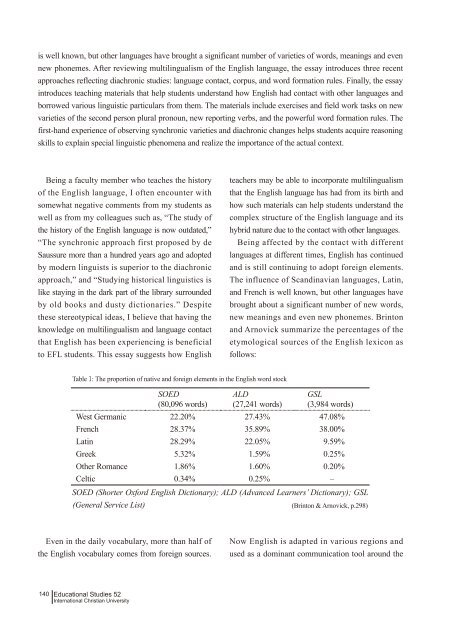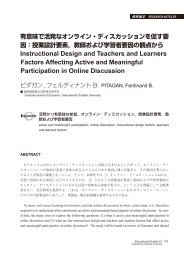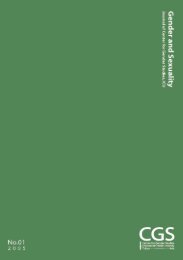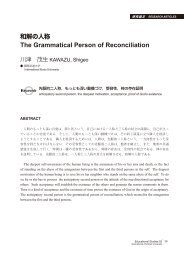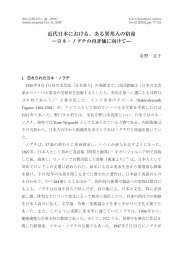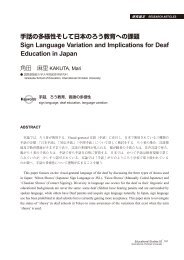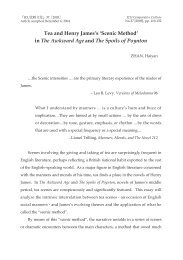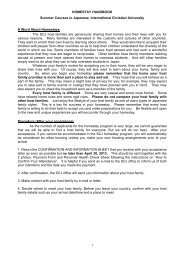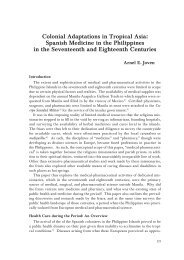is well known, but o<strong>the</strong>r languages have brought a significant number <strong>of</strong> varieties <strong>of</strong> words, mean<strong>in</strong>gs and evennew phonemes. After review<strong>in</strong>g multil<strong>in</strong>gualism <strong>of</strong> <strong>the</strong> <strong>English</strong> language, <strong>the</strong> essay <strong>in</strong>troduces three recentapproaches reflect<strong>in</strong>g diachronic studies: language contact, corpus, and word formation rules. F<strong>in</strong>ally, <strong>the</strong> essay<strong>in</strong>troduces teach<strong>in</strong>g materials that help students understand how <strong>English</strong> had contact with o<strong>the</strong>r languages andborrowed various l<strong>in</strong>guistic particulars from <strong>the</strong>m. The materials <strong>in</strong>clude exercises and field work tasks on newvarieties <strong>of</strong> <strong>the</strong> second person plural pronoun, new report<strong>in</strong>g verbs, and <strong>the</strong> powerful word formation rules. Thefirst-hand experience <strong>of</strong> observ<strong>in</strong>g synchronic varieties and diachronic changes helps students acquire reason<strong>in</strong>gskills to expla<strong>in</strong> special l<strong>in</strong>guistic phenomena and realize <strong>the</strong> importance <strong>of</strong> <strong>the</strong> actual context.Be<strong>in</strong>g a faculty member who teaches <strong>the</strong> history<strong>of</strong> <strong>the</strong> <strong>English</strong> language, I <strong>of</strong>ten encounter withsomewhat negative comments from my students aswell as from my colleagues such as, “The study <strong>of</strong><strong>the</strong> history <strong>of</strong> <strong>the</strong> <strong>English</strong> language is now outdated,”“The synchronic approach first proposed by deSaussure more than a hundred years ago and adoptedby modern l<strong>in</strong>guists is superior to <strong>the</strong> diachronicapproach,” and “Study<strong>in</strong>g historical l<strong>in</strong>guistics islike stay<strong>in</strong>g <strong>in</strong> <strong>the</strong> dark part <strong>of</strong> <strong>the</strong> library surroundedby old books and dusty dictionaries.” Despite<strong>the</strong>se stereotypical ideas, I believe that hav<strong>in</strong>g <strong>the</strong>knowledge on multil<strong>in</strong>gualism and language contactthat <strong>English</strong> has been experienc<strong>in</strong>g is beneficialto EFL students. This essay suggests how <strong>English</strong>teachers may be able to <strong>in</strong>corporate multil<strong>in</strong>gualismthat <strong>the</strong> <strong>English</strong> language has had from its birth andhow such materials can help students understand <strong>the</strong>complex structure <strong>of</strong> <strong>the</strong> <strong>English</strong> language and itshybrid nature due to <strong>the</strong> contact with o<strong>the</strong>r languages.Be<strong>in</strong>g affected by <strong>the</strong> contact with differentlanguages at different times, <strong>English</strong> has cont<strong>in</strong>uedand is still cont<strong>in</strong>u<strong>in</strong>g to adopt foreign elements.The <strong>in</strong>fluence <strong>of</strong> Scand<strong>in</strong>avian languages, Lat<strong>in</strong>,and French is well known, but o<strong>the</strong>r languages havebrought about a significant number <strong>of</strong> new words,new mean<strong>in</strong>gs and even new phonemes. Br<strong>in</strong>tonand Arnovick summarize <strong>the</strong> percentages <strong>of</strong> <strong>the</strong>etymological sources <strong>of</strong> <strong>the</strong> <strong>English</strong> lexicon asfollows:Table 1: The proportion <strong>of</strong> native and foreign elements <strong>in</strong> <strong>the</strong> <strong>English</strong> word stockSOED(80,096 words)ALD(27,241 words)GSL(3,984 words)West Germanic 22.20% 27.43% 47.08%French 28.37% 35.89% 38.00%Lat<strong>in</strong> 28.29% 22.05% 9.59%Greek 5.32% 1.59% 0.25%O<strong>the</strong>r Romance 1.86% 1.60% 0.20%Celtic 0.34% 0.25% –SOED (Shorter Oxford <strong>English</strong> Dictionary); ALD (Advanced Learners’ Dictionary); GSL(General Service List)(Br<strong>in</strong>ton & Arnovick, p.298)Even <strong>in</strong> <strong>the</strong> daily vocabulary, more than half <strong>of</strong><strong>the</strong> <strong>English</strong> vocabulary comes from foreign sources.Now <strong>English</strong> is adapted <strong>in</strong> various regions andused as a dom<strong>in</strong>ant communication tool around <strong>the</strong>140Educational Studies 52International Christian University
globe. Buck <strong>in</strong> an article entitled, “Why? and how?:Teach<strong>in</strong>g <strong>the</strong> history <strong>of</strong> <strong>the</strong> <strong>English</strong> language <strong>in</strong> ournew millennium,” asserts that “<strong>the</strong> history <strong>of</strong> <strong>the</strong><strong>English</strong> language is actually an <strong>in</strong>terdiscipl<strong>in</strong>aryfield ra<strong>the</strong>r than one that is narrowly def<strong>in</strong>ed.”Görlach <strong>of</strong>fers a concise explanation on <strong>the</strong> historicaldevelopment <strong>of</strong> <strong>the</strong> <strong>English</strong> language as follows:In a historical perspective, <strong>in</strong>dividual periods<strong>of</strong>fer <strong>the</strong>mselves for <strong>in</strong>vestigations <strong>of</strong> differentsubsystems <strong>of</strong> a language-for <strong>in</strong>stance, OE[Old <strong>English</strong>] for <strong>the</strong> functions <strong>of</strong> <strong>in</strong>flectionsand ME [Middle <strong>English</strong>] for its gradual loss,<strong>the</strong> massive borrow<strong>in</strong>g from many languagesand <strong>the</strong> consequences <strong>of</strong> this process, as wellas regional, social and stylistic diversity andmultil<strong>in</strong>gualism. (2001, p. 47)The multil<strong>in</strong>gual nature has made <strong>the</strong> language<strong>in</strong>tricately complex, but <strong>English</strong> teachers havetended to avoid expla<strong>in</strong><strong>in</strong>g such aspects <strong>in</strong> <strong>the</strong>irclassrooms. This essay is a proposal based on <strong>the</strong>actual classroom experiences on how to <strong>in</strong>corporatesuch knowledge and issues <strong>of</strong> ownership (Higg<strong>in</strong>s)for effective teach<strong>in</strong>g and learn<strong>in</strong>g.The first section outl<strong>in</strong>es <strong>the</strong> multil<strong>in</strong>gualismthat <strong>the</strong> <strong>English</strong> language has experienced s<strong>in</strong>ce itsbeg<strong>in</strong>n<strong>in</strong>g. Section Two reviews current approachesto language contact and language change. Thef<strong>in</strong>al section <strong>in</strong>troduces several teach<strong>in</strong>g materialsthat help students understand how <strong>in</strong>novative <strong>the</strong>language has been and still is. <strong>Incorporat<strong>in</strong>g</strong> <strong>the</strong>hybrid nature <strong>of</strong> <strong>the</strong> <strong>English</strong> language <strong>in</strong> actualteach<strong>in</strong>g materials will be mean<strong>in</strong>gful to EFLstudents if <strong>the</strong> materials enhance <strong>the</strong>ir learn<strong>in</strong>g <strong>of</strong> <strong>the</strong>historical development and changes that are currentlyoccurr<strong>in</strong>g.<strong>the</strong> language has a relatively short history comparedto o<strong>the</strong>r European languages. The follow<strong>in</strong>g is asummary from Russell’s book:Because <strong>of</strong> its situation on <strong>the</strong> western fr<strong>in</strong>ges<strong>of</strong> Europe, Brita<strong>in</strong> has always been a last resortfor peoples escap<strong>in</strong>g from wars and fam<strong>in</strong>es on<strong>the</strong> Cont<strong>in</strong>ent itself. Wave after wave <strong>of</strong> Celtictribes colonized <strong>the</strong> country <strong>in</strong> prehistoric times.. . When <strong>the</strong> Germanic Angles, Saxons, andJutes arrived <strong>in</strong> about 450 AD, <strong>the</strong>y soon cameto dom<strong>in</strong>ate <strong>the</strong> Celts. . . . After <strong>the</strong> NormanConquest <strong>in</strong> 1066, <strong>the</strong> Normans brought <strong>in</strong><strong>the</strong>ir vocabulary, controll<strong>in</strong>g <strong>the</strong> government,<strong>the</strong> legal system, <strong>the</strong> army, and <strong>the</strong> church, andlay<strong>in</strong>g <strong>the</strong> foundations <strong>of</strong> <strong>the</strong> class divisions thathave plagues <strong>English</strong> society ever s<strong>in</strong>ce. Thus,modern <strong>English</strong> is made up <strong>of</strong> three types <strong>of</strong>vocabulary:Anglo-Saxon words that are familiar,immediate, and <strong>the</strong>refore warm <strong>in</strong> tone;French borrow<strong>in</strong>gs that are more formal andpolite;More esoteric and learned Lat<strong>in</strong> loan words,that seem weightier, solemn, and more remote. (Russell, pp. 78-85)In Figure 1 Görlach depicts this multil<strong>in</strong>gualsituation and <strong>the</strong> radical functional expansion for<strong>English</strong> <strong>in</strong> <strong>the</strong> course <strong>of</strong> some 1300 years <strong>of</strong> itshistory. As immediately seen, <strong>English</strong> dialects havealways served for daily life, but for law documents,literature, and scholarly texts, Lat<strong>in</strong> and French, andlater Standard <strong>English</strong> have been dom<strong>in</strong>ant.2. Recent approaches <strong>in</strong> <strong>English</strong> l<strong>in</strong>guisticsto language contact and language change1. <strong>Multil<strong>in</strong>gualism</strong> <strong>in</strong> <strong>the</strong> development <strong>of</strong><strong>the</strong> <strong>English</strong> language<strong>English</strong> orig<strong>in</strong>ated as a Germanic dialect brought<strong>in</strong>to Britannia <strong>in</strong> <strong>the</strong> fifth century. This means thatThe three relatively new approaches <strong>in</strong> <strong>English</strong>l<strong>in</strong>guistics related to historical development are<strong>in</strong>corporat<strong>in</strong>g language contact and language change,us<strong>in</strong>g corpus-based approaches, and analyz<strong>in</strong>gpowerful word-formation rules.Educational Studies 52International Christian University141


